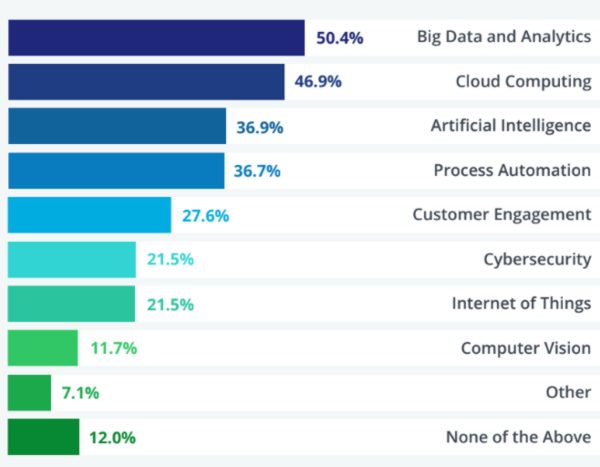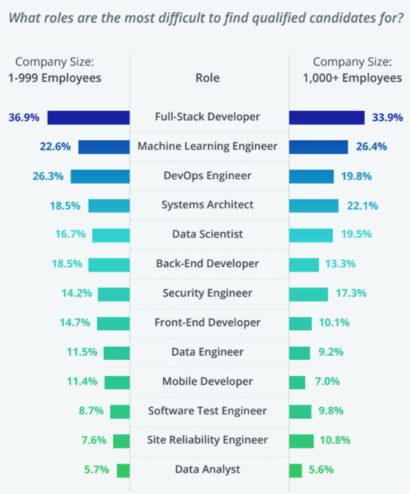| Hiring Landscape Under Scrutiny |
| Written by Janet Swift |
| Thursday, 05 March 2020 |
|
A new report from HackerRank reveals that 61% of smaller companies have a time-to-hire under 30 days, compared to 38% of larger companies and that Full Stack developers are the hardest to find for companies of all sizes. We recently ran a series of news items about the 2020 HackerRank Developer Skills Report which gives an in-depth look at the developers who are part of HackerRank's 7 million-strong developers. The other side of the coin is that HackerRank is used as a hiring platform by over 2,000 customers, including more than 25% of Fortune 100 companies. It comes as no surprise that the hiring process for tech jobs is a long and arduous one. A few years ago we looked at the interview process from the developer's point of view. Now we have some data from the other side of the fence, collected by HackerRank for its Tech Recruiting Benchmark Report Report, which is published today. This report presents the results of an online survey of 5,297 tech hiring leaders, including engineering managers, tech recruiters, and interviewers. While in many respects the jobs market is pretty favorable for developers - there are plenty of positions that need filling - there is still plenty of competition with bigger companies, those with over a thousand employees attracting more applicants per role. On average there are 566 applications for job openings in a large company compared to only 119 applications for those with fewer than a thousand employees but this is due to 5% of jobs at the former having over 5,000+ candidates. Another respect in which large companies differ from smaller ones is in the number of open technical job requisitions that recruiters handle concurrently. The average is 8 for a small company compered to 12 for a large company. The survey results also showed that companies handling more requisitions at once tended to have longer time to hire. Recruiters that handled 20+ concurrent requisitions had an average time-to-hire of 45 days, whereas those handling 4 or fewer concurrent requisitions averaged 29 days. Overall 61% of smaller companies have a time-to-hire under 30 days, compared to 38% of larger companies. In terms of the process, on average 26% of applicants are passed on to the phone screen stage, however 16% of survey respondents said that over half of applicants were passed through to the phone screen stage. On average, hiring teams pass 34% of phone screened candidates to the onsite stage. However, in the majority of cases less than 1 in 5 are passed to the onsite stage and only 17% of teams report a phone screen pass through rate of 40% or more. Across both large and small companies, it is mid-level developers, wit5h 2-5 years of experience who are most in demand, while larger companies are more likely to seek out senior developers than smaller companies: In terms of demand for"tech talent" demand, it is initiatives in big data and analytics are currently having the strongest impact followed by cloud computing, AI and process automation are also mentioned by more than a third of respondents:
Looking at the workload involved in filling open job positions the report notes that regardless of size, companies spend on average the same amount of time screening and interviewing candidates. In order to make a decision, each individual on the interviewing panel spends roughly 2.2 hours evaluating per candidate - from screening, to code reviews, to onsites, debriefs, and more. So the more candidates there are and the larger the interviewing panel, the more the investment in making a hire. Not all technical roles are equal when it comes to hiring. Some roles require a longer sourcing time and a greater evaluation time investment. Irrespective of company size, the role that hiring teams find most difficult to fill is that of Full-Stack developer. The report notes: The difficulty of defining the role, combined with the unique blend of required skills makes it an especially hard role to source for. Machine learning engineer, Devops engineers, systems architect, and data scientist are also problematic roles. while the easiest is data analyst.
More InformationHackerRank Tech Recruiting Benchmark Report Report Related ArticlesThe Tech Interview Process Lengthens What's Important To Get A Developer Job HackerRank Finds New Generation Gaps How Gen Z Could Fill the Skills Gap Devskiller Reveals Universal Demand For JavaScript To be informed about new articles on I Programmer, sign up for our weekly newsletter, subscribe to the RSS feed and follow us on Twitter, Facebook or Linkedin.
Comments
or email your comment to: comments@i-programmer.info |
| Last Updated ( Friday, 06 March 2020 ) |





